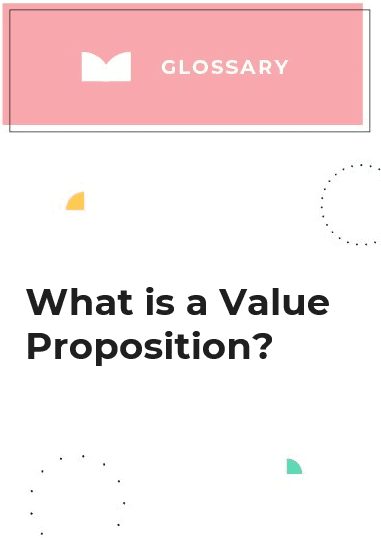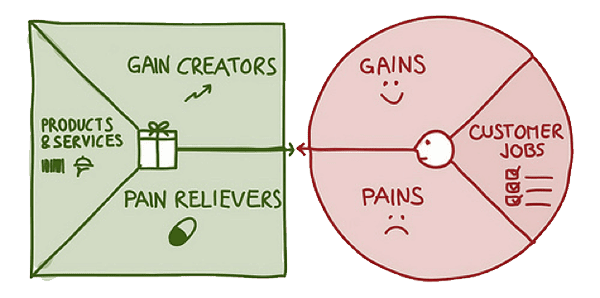
What is a Value Proposition?
A value proposition is a highly specific statement about your company that communicates what you’re offering, who you’re offering it to, and how it meets the needs of your customers. It’s a succinct piece of marketing artistry, articulating not only your product’s benefits, but a promise of value in some tangible form.
Strong value propositions share some common attributes – they’re articulate, short, and framed in a way that gets straight to the point. They’re typically aimed at a specific target audience of customers, but they can also be crafted for employees or other audiences.
Value Proposition Example
Your value proposition should clearly differentiate your business. That is, it should tell people why you’re different (and better) than your competition, and what benefit they get from shopping or working with you versus another company.
Successful value propositions are simple and compellingly direct. Some examples include:
- Vimeo – “The power of video at your fingertips.”
- Novo Watch – “We build the worlds most storied timepieces.”
- Less Accounting – “Straightforward solutions for freelancers, consultants, & small business owners to manage their own bookkeeping or hire us to help.”
The above examples are short statements that encompass the value a customer gets from the brand. These statements also differentiate each specific offering from competitors. For example, with Novo, you don’t just get a watch, you get a handmade piece of art created by skilled watchmaker.
What is the Purpose of a Value Proposition?
A value proposition captures the essence of why a customer should care about your company. It highlights the benefits you provide that make you uniquely poised to solve a problem – in a way that delivers the most possible value – for your customers.
Unlike a broad mission statement or catchy tagline, an effective value proposition zones in on the specific value you provide target customers. It spells out why you are the one for the job versus someone else. Is your solution cheaper, faster, more bespoke?
The purpose of a value proposition is to give customers a compelling reason to choose you over an alternative. Ultimately, it’s about connecting to human needs and demonstrating why your business best satisfies them.
Value Proposition Canvas
A value proposition canvas provides a framework around understanding what really matters to customers so you can create a value proposition that resonates. A canvas has two segments, each with three sections.
- The customer segment – This section states what jobs customers want to get done (jobs), what frustrations (pains) trip them up, and what outcomes (gains) they seek.
- The value proposition – This section forces you to see through the customer’s eyes so you can frame your offerings (products & services) in a way that demonstrates how they ease frustrations (pain relievers), and offer value (gain creators).
This canvas works like a mirror, reflecting customer realities so you can shape a value proposition that matches your customer’s truth. When business priorities align with human priorities, value propositions shift from generic claims to meaningful promises.
Here is an example of a value proposition canvas for an accounting tool aimed at small business owners and freelancers:
Customer Segment
- Jobs – SMBs, freelancers, and solopreneurs need to better understand their finances, help with filing taxes, record transactions accurately, and link multiple accounts.
- Pains – Confused by accounting jargon, limited time to manage books, bogged down with manual data entry, inability to analyze finances because they’re using multiple systems, tax prep is a slog and confusing.
- Gains – Seek simplified bookkeeping, financial insights, confidence in filing taxes, and automation to save time.
Value Proposition
- Products & Services – Simplified accounting software with user friendly, clear reporting capabilities, plus supportive training tailored to non-accounting experts running small businesses or solo ventures.
- Pain Relievers – User-friendly interface, customized guidance of accounting/finance concepts, automated processes (recurring billing, expense tracking, etc.) and comprehensive tax guidance.
- Gain Creators – Reduce time spent managing finances/bookeeping by 80%, get a more accurate idea of income/expenses thanks to better tracking, confidently manage cash flow, avoid accounting and tax errors.
How to Write a Value Proposition?
Once you’ve created your canvas, you can get down to the fun stuff – writing your value proposition. The goal is to craft messaging that your customers immediately grasp as being meant for them and their needs. When done right, that resonance and relevance is self-evident.
Here are some steps to clarify this process:
- Step one – Know who your target customer is and what problem you’re helping them solve. Really put yourself in their shoes to understand what they struggle with and where they need support. Do research, have conversations with your customer-facing teams, send out surveys, scan social media – whatever helps you truly empathize with their situation.
- Step two – Plainly lay out the products or services you offer that provide a solution. Explain as clearly as possible how your offering eases your customer’s pain or solves their problem and leads to tangible benefits (saving time, reducing costs, improving operations, etc.)
- Step three – Connect the dots for your customer between their needs and how your business can fulfill them. Spell it out so there’s no question about why your solution or product is right for their situation.
- Step four – Identify any unique value you provide versus alternatives they may be considering. Is there something you deliver faster, better, or more affordably? Call that out to differentiate yourself.
- Step five – Distill this all down into a tight statement focused wholly on introducing your customer to the value you offer. Get straight to the point of how you can help in a way that sounds authentic and relatable.
How Long Should a Value Proposition be?
Your value proposition generally is made up of three parts – a headline, sub-headline, and visual element. But it can also be a single sentence.
Remember, less is more when it comes to a value proposition statement. There’s no hard and fast rule for length, but you should aim to express your statement with 2-3 crisp sentences. Some sources say to keep it to about 30 words and, as we’ve seen, some value statements are much shorter than this. The exact phrasing isn’t as important as the clarity and brevity.
Don’t just describe what you sell – spell out the specific solution you offer and the promise of value you provide. Why is your product or service the best fit for their needs? How will it make their lives noticeably better? Start there.
Craft your message like you’re speaking directly to an individual customer about the benefits you can deliver to them specifically. The right value proposition should make your relevance and appeal obvious.
How to Ensure You Have a Unique Value Proposition?
Value propositions that stand-out are good at spotlighting what makes a business uniquely positioned to deliver exceptional value. When creating your value proposition, spell this out plainly by focusing on the following qualities:
- Specificity – Zero in on underserved customer needs.
- Originality – Highlight what’s unusual and innovative in your offering.
- Demonstrated Value – Back up claims with metrics, testimonials, and case studies.
- Clear Benefits – Put customer advantages front and center.
- Succinctness – Use just 2-5 super crisp sentences. No fluff.
- Differentiation – Draw sharp contrasts on your strengths vs. your competitors.

How Can A/B Testing Help Improve Your Value Proposition?
When you get right down to it, a strong value proposition is all about relevance, resonance, and personalization. That requires crafting a message that feels like it’s tailored just for your target customer’s specific needs. You want them to immediately grasp why your offering is the ideal fit to solve their problems.
A proven way to deliver that kind of relevance is through A/B testing – systematically testing variations of your value proposition and other messaging to determine what resonates with your audience. The data and customer feedback from A/B tests help you fine-tune language and positioning, so you can optimize your approach.
Monetate provides a comprehensive A/B testing and personalization platform to help uncover those optimization insights. Our flexible tools eliminate guesswork, allow you to conduct targeted tests across the customer journey so you can make data-driven decisions. By leveraging Monetate’s capabilities to iterate on and validate messaging, you can realize substantial improvements in crafting value propositions with that essential custom-fit feel. When done right, your audience will instantly recognize why your solution is meant for them.
